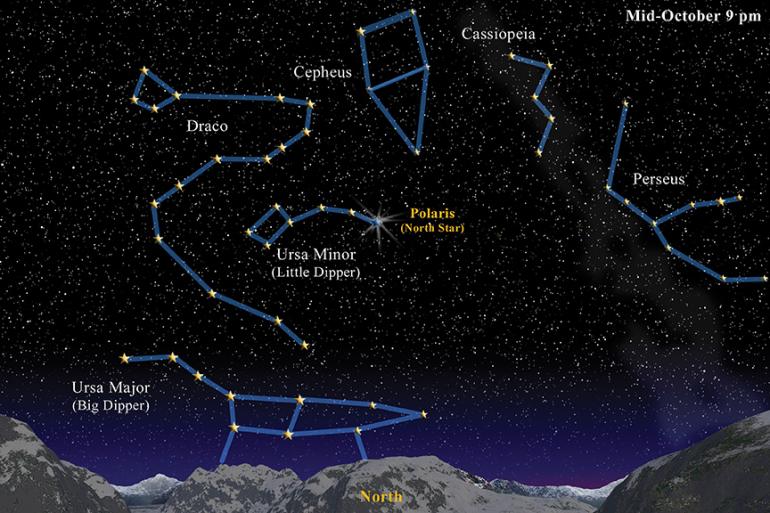Calamity Jane in the Sky
Fall stargazing.
One of the most iconic figures of the Old West, who spent time in Livingston and Bozeman during her notorious life, is Calamity Jane. How Martha Jane Canary acquired her provocative nickname is a matter of speculation, but the most plausible account has the city editor of the Cheyenne Daily Sun bestowing the moniker for her reputation of getting into trouble.
There’s a constellation in the sky that can relate.
Look north on fall evenings after dark, and you’ll find the equally iconic figure of the Big Dipper swinging low above the horizon. Follow its Pointer Stars (the two stars of the bowl farthest from the handle) up to the North Star and beyond, and you’ll find another familiar starry shape in the sky: the “W” of Cassiopeia the queen (though personally, I think it looks like an “M”).
The five-star shape is often seen as outlining the chair on which the queen sits, but it is perhaps better seen as a Ferris Wheel seat than a throne, for as the sky turns, we can watch the queen go round and round the central spoke of the North Star.
This actually fits with her story—but a calamitous queen was not the only thing seen in these stars. Every culture had its own opinion. The Pawnee saw here the south end of a rabbit heading north, for example, with the stars marking the bunny haunches and tail. The Snohomish people saw the skin of a giant elk; the stars marked the holes punched in the pelt when it was staked out to dry. Arabs saw the hump of a great camel, Laplanders a moose antler, Marshall Island natives the tail of a great dolphin. And the Siberian Chukchee saw a small herd of five reindeer in the sky.
To the Chinese, the stars marked Wang Liang, a famous charioteer of their own iconic past. Arabs additionally saw a female hand anointed with henna to protect it against the desert heat—and some in the Middle East called the pattern “The Lady in the Chair,” bringing us back to the ill-fated Cassiopeia.
Queen Cass was the legendary wife of Cepheus, according to Greek myth, and together they ruled the kingdom of Ethiopia (not the current country, but a realm on the Mediterranean coast). The queen was certainly fetching, but had an ego to match. One day, she boasted that she was more beautiful than the nymphs of the sea. Word got back to the nymphs, who went off in a huff to complain to the sea god Poseidon, who promptly dealt out payback by sending the sea monster Cetus to ravage the coastal kingdom. Adding to their troubles, the sovereigns’ only recourse, apparently, was to chain their daughter Andromeda to the beach as a sacrifice to Cetus, hoping he would take the proffered snack and go away.
"The five-star shape is often seen as outlining the chair on which the queen sits, but it is perhaps better seen as a Ferris Wheel seat than a throne, for as the sky turns, we can watch the queen go round and round the central spoke of the North Star."
The strapping hero Perseus intervened in the nick of time. Fresh from his slaying of the Gorgon Medusa, he swooped down on winged sandals (or the flying horse Pegasus—his mode of transportation differs according to who tells the story), pulled Medusa’s head out of his satchel, and showed it to the beast.
The snake-haired Gorgon was known for an icy stare that could turn men to stone, and it did the trick on the sea monster as well. As the ossifying creature sank beneath the waves, Perseus plucked the princess from the beach. They married, started a royal dynasty of their own, and were themselves promoted to constellations, and with Pegasus and Cetus, dominate the southern fall sky.
Cassiopeia might have expressed a sigh of relief, but she didn’t get off so easily. Ultimately, she and her husband Cepheus (who sits alongside her shaped like a house), were also placed in the sky near the pole, where they circle continually and spend half their time upside down, the blood rushing to their heads.
The queen is periodically zapped by other calamities as well: exploding stars called supernovae were recorded in the constellation in 1181 and 1572. Another, whose light should have reached us around 1700, was apparently obscured by intervening dust, but is today called Cassiopeia A and is one of the brightest radio sources in the sky.
But there’s no obscuring the lesson in humility exemplified here: what goes around, comes around. And so we come full circle, as it were, back to the Ferris Wheel seat in which Calamity Cass sits in her endless circuit in the sky.
Jim Manning, formerly the executive director of the Astronomical Society of the Pacific in San Francisco, lived outside Bozeman for many years and has returned to live here once again.












